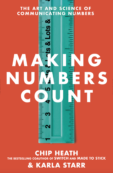Here’s a story from Dave Rendall, who has a blog called the Freak Factor. (I love his post that argues that if you’re getting rejected, you’re doing something right.)
I hadn’t seen Tammy in almost a year, when she approached me in the hallway. I was there to teach an evening class for non-traditional students. She told me that her cohort was about to complete their last class and invited me to join the celebration. When I arrived, she was anxious to share some news.
Tammy had taken my course in Organizational Behavior the previous fall and one of the topics is change management. The classic model for this concept is Kurt Lewin’s force-field analysis, which helps managers to envision the driving forces pushing change and the restraining forces acting against change. By understanding and manipulating these forces, effective changes can be achieved. However, this is a relatively abstract concept and can become very complex in the context of an organization.
In order to make this concept stick, I use a few of the SUCCES principles from MTS. I start by keeping it simple. Instead of applying this model to an organization, I start by asking students to choose a meaningful change that they’ve been wanting to make in their own life, but haven’t started yet. Selecting a change that matters to them also creates an emotional link to the activity.
They write this change in the middle of a piece of paper and then I ask them why they want to make this change. These reasons are the driving forces and are listed on the left side of the paper on arrows pointing to the right. We then consider the barriers to making the change. These restraining forces are listed on the right side of the paper on arrows pointing left.
To make the activity more concrete, I try to physically illustrate the action of the two forces. I stand in front of the class with a chair and ask for a volunteer. The chair signifies the change, I am the driving forces and the volunteer is the restraining forces. I push the chair and the other student pushes back. The chair doesn’t move. It is “frozen.”
This illustrates the importance of “unfreezing,” which is the first part of Lewin’s change model. “Changing” occurs when driving forces are strengthened or added and when restraining forces are weakened or removed. Before explaining this, I ask the students how I can get the chair to move. The suggestions usually include the four options listed above. Without even reading the text, students can figure out how the process works in the physical world. In fact, during one class a student’s 10 year-old son was in the room. When I asked how to move the chair, the room was silent. The first person to respond was the young boy. He said, “Add more force!” He was exactly right and I was very pleased. I had made Lewin concrete and simple enough for a child to understand.
The activity is also credible because it offers a testable credential. Students are asked to assign numerical values to the strength of their driving and restraining forces. The cumulative scores for each set of forces shows why they haven’t made the change yet (not enough driving force and/or too much restraining force). We then work to increase driving forces and decrease restraining forces. The students always come up with creative ideas that they can apply to their own life. We discuss these as a class so students can see for themselves how it can work in their situation and those of their classmates.
I also share stories of how I’ve used this model to create change in my life. Each time I teach this concept, I choose a change that I want to make and work through the exercise along with the students. This creates a growing list of stories of success and failure, which brings us back to Tammy.
She wanted to start her own business. During the course of the exercise, she explained her driving and restraining forces. I asked if it was possible that her current job might also be a restraining force. Since she liked her job and was paid well, she did not have a lot of natural motivation to go out on her own. Even though she had a good job, it might actually be a barrier to achieving her change. I don’t recall her response at the time and I didn’t think much about it or hear anything from her until ten months later.
When I went to her classroom, she explained that she quit her job shortly after class and started her own business as a Spanish language interpreter. The business was even more successful than she anticipated and she was very happy. She credited the Lewin exercise for giving her the necessary insight and motivation to make a major change in her life. Needless to say, this is a story that I now share with classes to demonstrate the potential power of applying Lewin’s force-field analysis.



